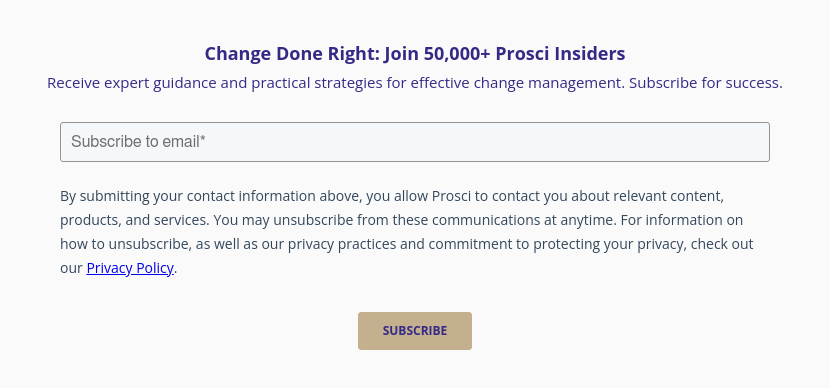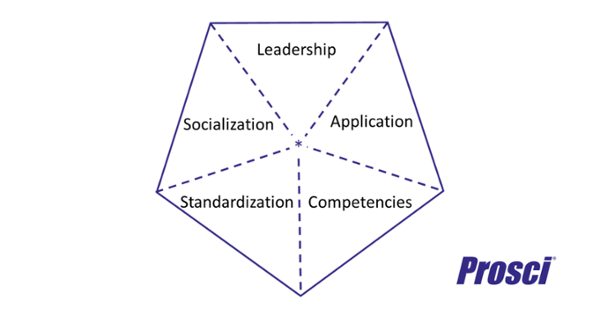Organizational Agility Starts on the Human Side of Change

9 Mins
Updated: August 19, 2025
Published: August 23, 2018

Change is no longer an event—it’s a constant. Organizations today face faster, more complex, and more frequent disruptions than ever before. From digital transformation to shifting market demands, the ability to adapt quickly and effectively is now a matter of survival.
Yet, organizational agility isn’t only about adopting new processes or technologies. It starts with people. According to a 2024 study by the Journal of Entrepreneurship, Management and Innovation, “Agile leadership is strongly associated with enhanced organizational performance, effectiveness, and innovation management.”
But what truly enables agility?
The answer lies in how well organizations support people through change. This article explores the human side of organizational agility, providing practical strategies for leaders to build a culture of adaptability, empower employees, and create a change-ready workforce. Because in the race for agility, the organizations that invest in people will be the ones that lead.
What Is Organizational Agility?
The term “agility” has become something of a buzzword in recent years—yet defining it in the organizational sense isn’t as straightforward as it might seem.
Before we share the Prosci stance on defining agility, here are some of the definitions offered across the literature:
- “The ability of an organization to swiftly and efficiently respond to changes in the organization’s environment.” —Future Business Journal, Disentangling organizational agility from flexibility, adaptability, and versatility: a systematic literature review
- “Creating a nimble, responsive organization capable of not just surviving but thriving amidst continuous change.” —Agile by Design, Organizational Agility - A Complete Guide
- “The ability of a company to: Adapt to external and internal changes. Rapidly meet customer demands and expectations. Lead change improving culture, practices, and outcomes. Maintain a continuous competitive advantage.” —David J. Anderson School of Management, Organizational Agility
For more definitions of organizational agility—and its role as a strategic imperative—take a look at this episode of the Project Chatter podcast.
At Prosci, we synthesized different perspectives on agility to arrive at six defining components. The image below shows these components ranked by the participants of a Prosci webinar—Organizational Agility: A Strategic Imperative—based on which resonated most with them.
 Although there isn't a single definition of organizational agility, exploring its various components can help you identify what’s most valuable for your colleagues, coworkers and collaborators.
Although there isn't a single definition of organizational agility, exploring its various components can help you identify what’s most valuable for your colleagues, coworkers and collaborators.
What Are the Attributes of an Agile Organization?
After exploring the definition, the conversation quickly shifts to: What attributes do agile organizations share that make them an agile company? As with the definition, there are various perspectives in this arena.
Prosci surveyed the literature and found a number of leading contributors who provide their own pillars of agile organizations. For example, PricewaterhouseCoopers has five, Accenture provides nine, and xPlane offers eight.
Prosci's 10 attributes of agile organizations
Based on these inputs, along with Prosci research and client experience, we created ten attributes of organizational agility:

Agility Assessment: Consider each statement in the list and rank your organization on a scale of Strongly Disagree to Strongly Agree.
During the Building Organizational Agility webinar, we asked over 250 participants to complete the assessment described above in real time. The results are shown below:

The attributes that respondents scored the highest were:
- We encourage cross-organizational collaboration
- We anticipate and plan for changes
- We have enhanced risk management practices
The attributes that respondents scored the lowest were:
- We are fast at decision-making
- We effectively prioritize and manage our change portfolio
- We have human capital (talent) strategies supporting agility
Given the changing business landscape and executive attention being paid to agility, there is tremendous potential to embed agility as a “state of being” for organizations who want to be the winners of the future.
However, achieving this sought-after business agility relies on more than just processes—it needs a people-focused approach that enables a true shift in organizational culture.

Why Is Organizational Agility Important?
Organizational agility isn’t just about moving fast—it’s about adapting effectively to change. In an era of constant disruption, companies that embed strategic agility into their culture, leadership, and ways of working will outperform those that cling to rigid structures.
As an agile company that prioritizes the human side of business agility, you stand to unlock a range of benefits. From becoming more resilient to empowering your employees, are some of the key benefits of organizational agility:
Improved responsiveness to change
Agility allows you to adapt quickly to dynamic market conditions and evolving customer demands. This responsiveness helps you seize new opportunities and gives you a competitive edge that keeps you ahead of the market.
Increased innovation and resilience
Agile organizations foster a culture of continuous improvement, one that gives employees the freedom to experiment and innovate. This creative approach can improve the quality of products and services, and make your organization more resilient in the face of challenges and disruptions.
Higher employee engagement
When you take a people-centric approach to agility, you empower your employees to take ownership of their roles, responsibilities and the decisions they make. This leads to higher employee engagement, which makes your people feel valued. As a result, they’re more likely to adopt and sustain change.
Better change outcomes with strategic agility
Agility without structure can quickly lead to chaos. Integrating strong change management principles with structured business agility ensures the people side of change is effectively managed, making it more likely that changes stick, adoption rates improve and initiatives succeed.
While the benefits of organizational agility are clear, achieving them isn’t always straightforward—especially when ingrained mindsets, rigid hierarchies and organizational siloes stand in the way.
The Human Challenges of Becoming an Agile Organization
For many organizations, the biggest obstacle to agility isn’t technology or strategy. It’s understanding how to prepare, equip and support people through the changes that enable agility in the first place. A structured approach to managing change can ensure a smoother transition and long-term success.
Let’s explore some of the human factors involved in organizational agility and how these can be addressed using the Prosci Methodology.
Cultural resistance to change
Cultural resistance to change is one of the biggest roadblocks to organizational agility—not because people don’t want to change, but because deep-rooted habits, norms and legacy processes make change feel unsafe or unnecessary. As a result, people become comfortable with “the way we’ve always done things,” creating cultural inertia that inhibits adaptation and innovation.
Adopting a more agile business model means challenging long-standing beliefs and encouraging flexibility, rapid decision-making, and a proactive approach to change. This shift can’t be achieved with surface-level initiatives; it demands a strategic and sustained effort to reshape organizational culture.
A practical way to do this is to support individuals in their personal change journeys, reinforcing the cultural shift at scale. The Prosci ADKAR® Model helps address the human side of cultural transformation by guiding employees through the five outcomes necessary for successful transitions:
- Awareness – Helping employees understand why the change is happening and what benefits it brings.
- Desire – Encouraging support by involving employees in the process and addressing their concerns.
- Knowledge – Providing training and resources to help employees learn how to navigate the change.
- Ability – Offering tools, coaching and support so employees can apply their knowledge in practice.
- Reinforcement – Recognizing and rewarding behaviors that reflect the new culture and sustaining momentum through regular feedback.
Prosci ADKAR Model

The role of leadership in an agile organization
Leadership is one of the most significant enablers—or barriers—to organizational agility. Traditional top-down management structures, built on rigid hierarchies and centralized decision-making, can slow responsiveness and discourage innovation.
To counter this, leaders should actively communicate the vision for agility, model adaptable behaviors, and support teams in navigating changes. In the pursuit of improved organizational agility, engaged leadership helps create a sense of purpose and direction.
Effective change management can equip leaders to adopt these changes. For example, the Prosci Methodology defines specific roles for leaders, which includes actively and visibly participating, building coalitions of sponsors, and communicating directly with employees affected by change. This provides the framework for clear communication about the vision and encourages engagement in the change process.
Lack of psychological safety
Organizational agility requires a culture where employees feel safe to experiment, speak up, and challenge the status quo. Without psychological safety, people hesitate to share new ideas or admit failures, leading to risk-averse behaviors that slow adaptability.
The Prosci Methodology helps create a culture where employees feel able to express themselves, engage with change, and collaborate effectively. It achieves this by promoting open communication, building trust, and providing necessary support.
Misalignment between agility and organizational structures
Even the most adaptable mindset can be constrained by rigid organizational structures. Traditional bureaucracies, strict hierarchies and departmental silos create bottlenecks that slow decision-making, inhibit collaboration and limit responsiveness.
Strategic agility means rethinking how you operate—to break down silos, enable cross-functional team collaboration, and decentralize decision-making. By redesigning your structures to support agile teams, you become more flexible, innovative, and capable of responding quickly to change.
The Prosci Enterprise Change Management (ECM) Framework emphasizes the integration of change management into various aspects of the organization. It addresses misalignment between agility and organizational structures by fostering leadership engagement, project alignment, skills development, structural adaptation and process integration.
Prosci ECM Framework Showing 5 Capability Areas

Change Management as the Foundation for Organizational Agility
As we’ve seen, organizational agility depends on employees' ability to understand, adopt and sustain organizational project changes and initiatives. People are mostly likely to adopt such changes when organizations prepare, equip and support them throughout the transition.
Prosci research shows that large-scale initiatives, including those that drive organizational agility, are more likely to succeed with support from excellent change management.
Correlation of Effective Change Management With Success

How to Improve Organizational Agility With a People-Focused Approach
To enhance strategic agility and nimbleness, you can adopt several key practices that focus on flexibility, responsiveness and proactive decision-making.
Here are some actionable strategies to enhance organizational agility by integrating Prosci’s people-focused change management approaches.
1. Foster a culture of adaptability
Improving organizational agility means shifting organizational culture. Employees need support to adopt a mindset that embraces change and innovation within an environment that fosters experimentation and adaptation.
Here’s how a structured approach to change management can help foster a culture of adaptability that drives organizational agility:
- Focus on individual change – By helping employees navigate their personal change journeys, you can cultivate a more adaptable workforce that is better equipped to respond to changes.
- Engagement and involvement – Actively involving employees in discussions about changes that drive organizational agility builds a sense of ownership and commitment, making it easier for people to adapt to new ways of working.
- Common language for change – Establishing a common language for change through the ADKAR Model reduces confusion and fosters a shared understanding, making it easier for teams to adapt to new circumstances.
- Emphasis on reinforcement – By celebrating successes and recognizing individuals who exemplify agile behaviors, organizations can create a culture that values and promotes organizational agility.
Discover how a global manufacturing organization embedded change management to foster a culture of adaptability in this case study.
2. Encourage continuous learning
Promoting a culture of continuous learning and professional development can improve organizational agility. By equipping employees with skills and knowledge that align with strategic agility, they can adapt more easily to changing environments.
Our ADKAR Model facilitates continuous learning through its Knowledge, Ability and Reinforcement elements. Here’s how you can apply it:
- Training and development – Offer training programs, workshops and resources that facilitate continuous learning.
- Practical skills application – Provide opportunities for hands-on practice and real-world application of new skills to reinforce learning and encourage ongoing development.
- Rewarding agile behavior – Celebrate achievements related to continuous learning to motivate others to pursue similar paths.
3. Strengthen leadership’s role in agility
Embedding agility into your organizational culture demands bold, structured leadership that empowers individuals at every level, aligns executive behavior with agile principles, and redesigns organizational systems to fuel continuous transformation.
You can achieve this by:
- Clearly defining leadership roles – The Prosci Methodology outlines specific roles for leaders. This clarity helps leaders understand their responsibilities and the impact of their engagement on the success of agile initiatives.
- Prioritizing sponsorship – Effective sponsors are critical for driving agility. Leaders should be active participants in the change, modeling agile behaviors, and encouraging their teams to embrace new ways of working.
- Providing training for leaders – By investing in leadership development, organizations empower their leaders to engage with employees, address concerns and drive agile initiatives forward.
4. Facilitate cross-functional collaboration
Cross-functional collaboration is a cornerstone of true organizational agility. It requires dismantling silos, challenging conventional hierarchies, and reimagining how teams work together.
By fostering this kind of interconnectedness, organizations unlock faster knowledge flow, sharper decision-making, and the ability to adapt in real time to evolving market demands and customer expectations.
Creating a dedicated change management office (CMO) to support change management efforts can serve to facilitate collaboration and eliminate agility-hindering siloes. The CMO provides a centralized function for managing change initiatives and helps create a more flexible organizational structure that can respond quickly to changing needs.
5. Embed change management into organizational agility transformations
To transform an organization into an agile and adaptable one, change management must be built into the foundation. Embedding change management into agility efforts ensures that new ways of working are fully adopted, sustained and scaled across the organization.
Structured approaches like the Prosci 3-Phase Process offer a clear yet adaptable framework to drive successful outcomes at every stage of transformation:
- Phase 1 – Prepare Approach – Define what agility looks like for your organization, identify the people most affected, and craft a strategy that aligns change management with business priorities.
- Phase 2 – Manage Change – Implement intentional, flexible plans to drive adoption, track real-time impact, and refine tactics based on employee and team feedback.
- Phase 3 – Sustain Outcomes – Reinforce agile behaviors, empower teams to lead change from within, and embed continuous adaptation into the organization’s DNA.
Prosci 3-Phase Process
 Armed with a structured change management framework, your organization builds the muscle to anticipate change, adapt faster, and embed a culture of relentless improvement that fuels long-term agility.
Armed with a structured change management framework, your organization builds the muscle to anticipate change, adapt faster, and embed a culture of relentless improvement that fuels long-term agility.
Integrating Change Management Into Organizational Agility: Insights From Prosci
Prosci has spent near two decades researching how organizations move past a project-by-project approach to change management and build true organizational change management capability.
Here are a few areas where we help bring this research and development to life:
- The latest edition of Prosci’s Best Practices in Change Management report has an entire section focused on change management applications.
- Prosci Enterprise Change Management (ECM) Boot Camp is a one-day training program on how to apply structure and intent to the Enterprise Change Management effort.
- Prosci Advisors offers clients coaching and deployment support to accelerate the results along your change management journey.
Bringing It All Together: Agility Powered by People
Organizational agility doesn’t result from new processes or technologies—it comes from equipping people to adopt change successfully.
Change management provides the structure to turn organizational agility from an aspiration into reality, offering a people-centric approach that supports employees to embrace and sustain the changes that drive strategic agility. In a world where change is the only constant, the most agile organizations will set the pace. Will you be one of them?




